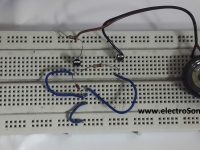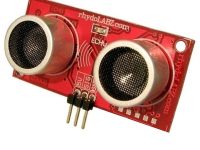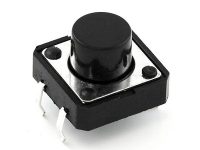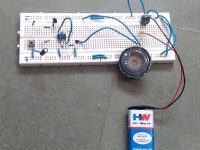Condenser Microphone

You might know that Condenser means Capacitor, the electronic component which stores electrical energy in the form of electrostatic field. As the name indicates the condenser microphone uses a capacitor to convert sound (pressure variations) to electrical signals. Hence it is also called Electrostatic Microphone. We all know that a capacitance will be created when two parallel plate conductors are separated by a distance. The created capacitance will be directly proportional to the area of the plates and inversely proportional to the distance between the plates.
The basic constructional diagram of a condenser microphone is shown above. It consists of a parallel plate capacitor formed by Black Plate and Front Plate. The Diaphragm of the mic is used as Front Plate. Sound energy produces vibrations in the Diaphragm which changes the distance between plates. Which results in the changes of capacitance. When the distance between plates decreases, capacitance increases which results in the flow of charging current. When the distance between plates increases, capacitance decreases which results in the flow of discharging current.
Thus a condenser microphone produces capacitance variations corresponding to sound signal, so to convert it to electrical signal an external power must be connected to it.
There are two types of condenser microphones depending on how external power is connected to it or how the electrical signals are extracted from capacitance variations.
DC Biased and RF Condenser Microphones
DC Biased Condenser Microphones are biased with a fixed charge (say Q). As the capacitance changes, voltage across the microphone (say V) changes according to the capacitor equation (C = Q/V), where C is the capacitance in farads. As the capacitance changes, charge across the capacitor changes slightly but for audible frequencies it can be treated as constant as the change is very small. The capacitance of the mic ranges from 5 to 100pF and resistance of the bias resistor ranges from 10MΩ to tens of GΩ. This capacitance and bias resistor acts as a high pass filter for audio signals and as a low pass filter for the bias voltage.
RF Condenser Microphones uses a low voltage RF generated by a low noise generator instead of DC Bias. The signal from oscillator may either be amplitude modulated by the varying capacitance or the varying capacitance may be a part or the resonant circuit that produces oscillations produces frequency modulation. Demodulating the signal modulated by the varying capacitance will provide us a low noise audio signal. The absence of high bias voltage permits us to use a diaphragm with looser tension and it can be used to acquire wider frequency response.
Electret Condenser Microphone
These type of microphones uses a special type of capacitor that has a permanent charge or voltage built during manufacture. Thus it doesn’t requires external power for its operation. The permanent charge is provided by a material called electret. Electret is a ferromagnetic material that is permanently charged or polarized. Due to their good performance and ease of manufacture (hence low cost) majority of the microphones made today are electret microphones. It is commonly used in mobile phones, computers and headsets. Eventhough this kind of microphone doesn’t require external power, good ones include a pre-amplifier which requires external power.














what is the order of voltage that mic produce as output.
THANKS.. GOT IT.
A lot of amplifier circuits are available over internet. Just search for audio amplifier circuit.
hi.
how to amplify 10mv into 5v dc ??
i want to amplify my mobile phone voltage coming from ear phone.
thanks.